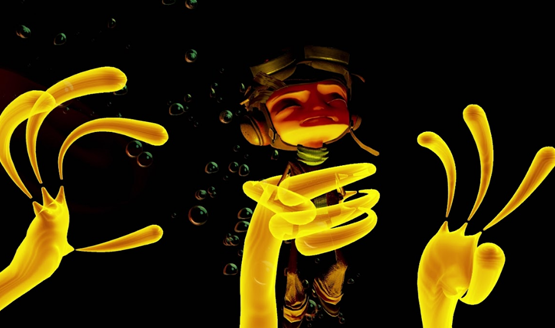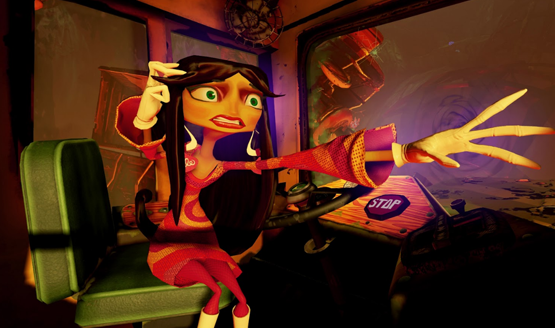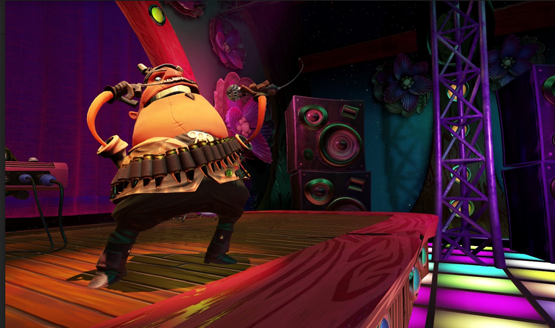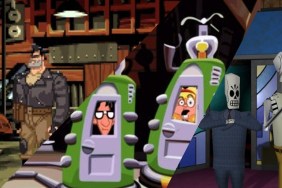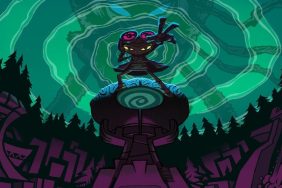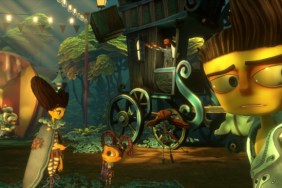Psychonauts was one of my favorite games of the PlayStation 2 era. It blended fun platforming with the benchmark bizarre style and humor that Double Fine quickly became known for. While Tim Schafer had been adding his quirky flavor to games for many years before Psychonauts released in 2005, it was the first title under Schafer’s own studio, Double Fine, founded after he left LucasArts. In the decade since, fans have been clamoring to return to the psychic world of Psychonauts. We’re getting a full fledged sequel next year, but in the meantime PlayStation VR owners get treated to a small midquel — a word that doesn’t technically exist — to bridge the gap between the two games.
Retaining a characteristically colorful Tim Burton style vibe, the art style and level of detail is perfect for the type of immersion that VR offers. Too often I was content to just look around each environment, absorbing the small in-jokes and bizarre ambiance. While it’s built to delight many, there’s an attention to detail that will satisfy the longtime fans of Raz and his extrasensory cohorts. Aside from the obvious connection in it being a follow-up, there are a number of small references to gameplay mechanics and narrative bits that only players of the original game will catch. It’s that idiosyncratic Double Fine wit at work, and it really helps to make Rhombus of Ruin feel like a game for the fans of both Psychonauts and other Double Fine projects — the fans who have a PlayStation VR headset, that is.
Whether you’ve played the first game or not, Rhombus of Ruin is helped along by the return of the original voice cast, who each lend a distinct and animated personality to the characters they play. As with any Double Fine game, listening to the conversation and voice lines is a core part of the experience. There are a number of triggers, and probing each option can elicit some great lines, again with that particular wit that helped make the first game such a cult classic. Sometimes offbeat, intermittently nonsensical, and altogether entertaining, the writing in Rhombus of Ruin is the kind of topnotch work that I have come to expect from Tim Schafer and Double Fine.
Psychic Reality
Psychic powers end up being the perfect use of virtual reality, as they employ the power of the mind, not physical abilities. Exclusively using the DualShock 4, with no support for the PlayStation Move, gameplay is mostly comprised of switching to other stationary living things’ minds in order to get different views on the environment and figure out how to move forward. Psychic blasts, telekinesis, and pyrokinesis allow for a variety of solutions to certain puzzles, and it’s all a great way to fit the motion sickness mitigating gameplay of multiple stationary points into the narrative, making it feel more natural and less immersion breaking. Jumping from mind to mind just makes sense for a Psychonaut.
It’s disappointing then to have the whole arsenal of a psychic’s mind at my disposal, but be limited to the simplistic puzzles and linear gameplay that Rhombus of Ruin produces. There are a few puzzle rooms that did require me to stop briefly and think, but most of the game requires very little in the way of skill or thought to work through as traveling between these puzzle rooms is relatively slow in the gameplay department. There’s a lot less to do with your mind than one might think a Psychonauts game would have. Replayability is similarly stunted. The original Psychonauts was fraught with collectibles (technically over 1,000 of them, if you include the figments). Outside of observing the environment and listening to character lines, Rhombus is devoid of any collectibles or reasons to go through the game again once you’ve finished. Even taking my time, looking around, and trying to prod and explore the world, I finished Rhombus of Ruin in under two hours.
In that short length though, Rhombus of Ruin ends up manifesting many of the little things that make virtual reality great for immersion in the fictional world. It’s obvious that Psychonauts has a Tim Burton look and feel in its bizarre, loosely human aesthetic, but there’s one sequence in Rhombus of Ruin that has a certain Laika vibe, using stop-motion and dolls to evoke something similar to Coraline. Despite having very little interactivity, being a voyeur to this stop-motion story is one of my favorite parts of the game. It really makes me want Laika to do some work in VR, or maybe even team up with Double Fine (why not both?).
There are also brief moments where I had to inhabit the mind of something large, making the environment seem small, and getting into the brain of something puny, causing the whole world to rise up and feel enormous around me. These are both impressive feelings that virtual reality is particularly capable of presenting in a way that drives a sense of presence unlike other mediums. Despite so many VR experiences being short and succinct, they somehow always manage to have tidbits that get me dreaming up so many other great ideas for VR, and Rhombus of Ruin is no different.
There are a few boxes that you ought to check if you are thinking about Psychonauts in the Rhombus of Ruin. As a fan, it would be all too easy for me too lose myself and say that this is amazing and a must have, but for anyone that hasn’t played it, they might only find an amusing, yet scant VR experience. As great as it is to revisit Raz and the charming Double Fine writing before the sequel debuts in 2018, Rhombus of Ruin is replete with the very things that have plagued early VR titles: short length, lack of replayability, and being so accessible that it requires little skill or thought to complete. Psychonauts in the Rhombus of Ruin is a game made specifically to appease the fans as Double Fine dips their toes in VR development and prepares the world for the second coming of Razputin Aquato, but this level of immersion is like psychically diving into the mind of Tim Schafer himself, and that alone is worth the trip.
Psychonauts in the Rhombus of Ruin review code provided by developer. Reviewed on PSVR. For more information on scoring, please read our Review Policy.
-
Classic Double Fine charm
-
The original voice actors are back
-
World is detailed and bizarre
-
Some great VR moments
-
Painfully brief
-
Accessibility means little skill or thought is required
-
Replayability is severely limited
